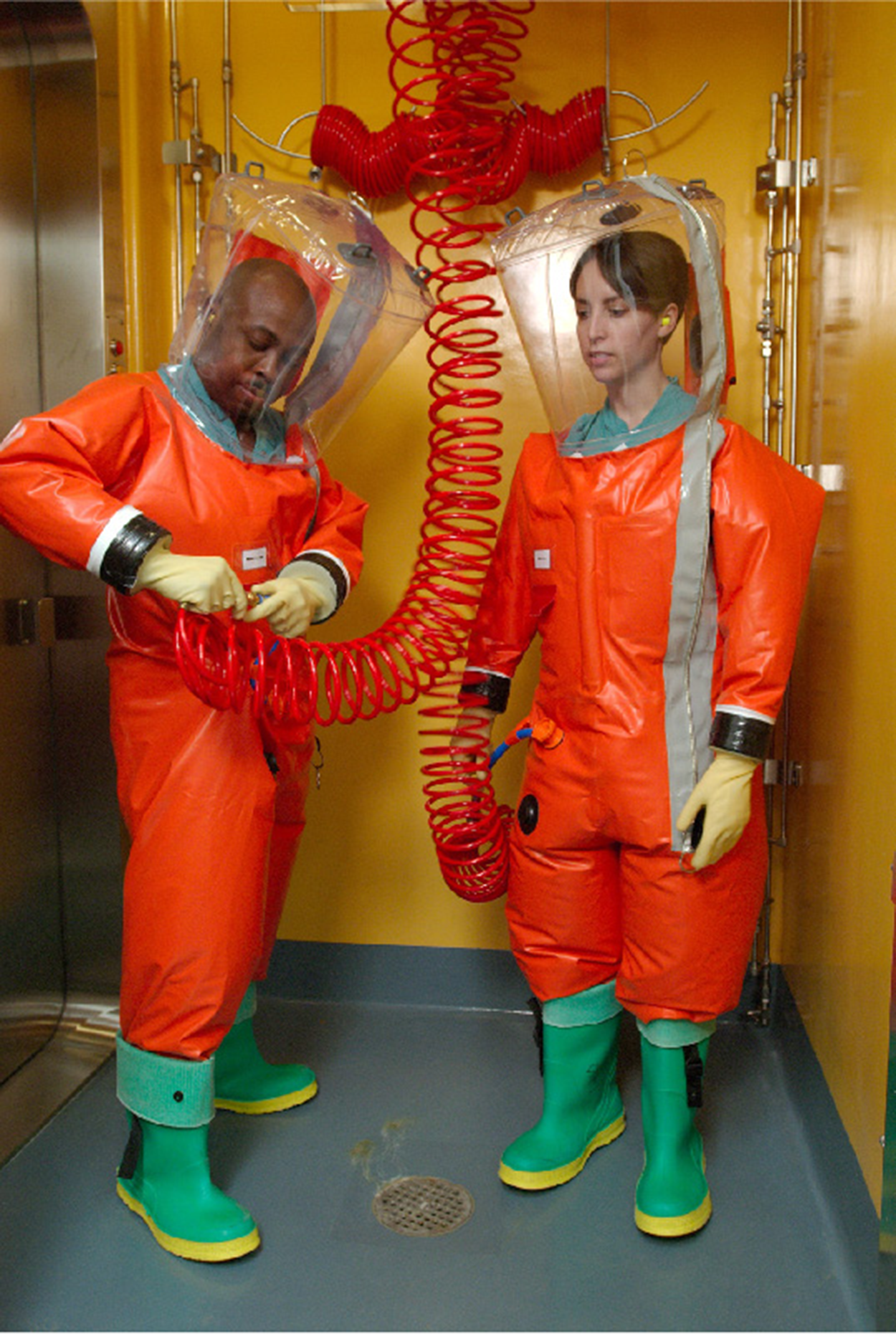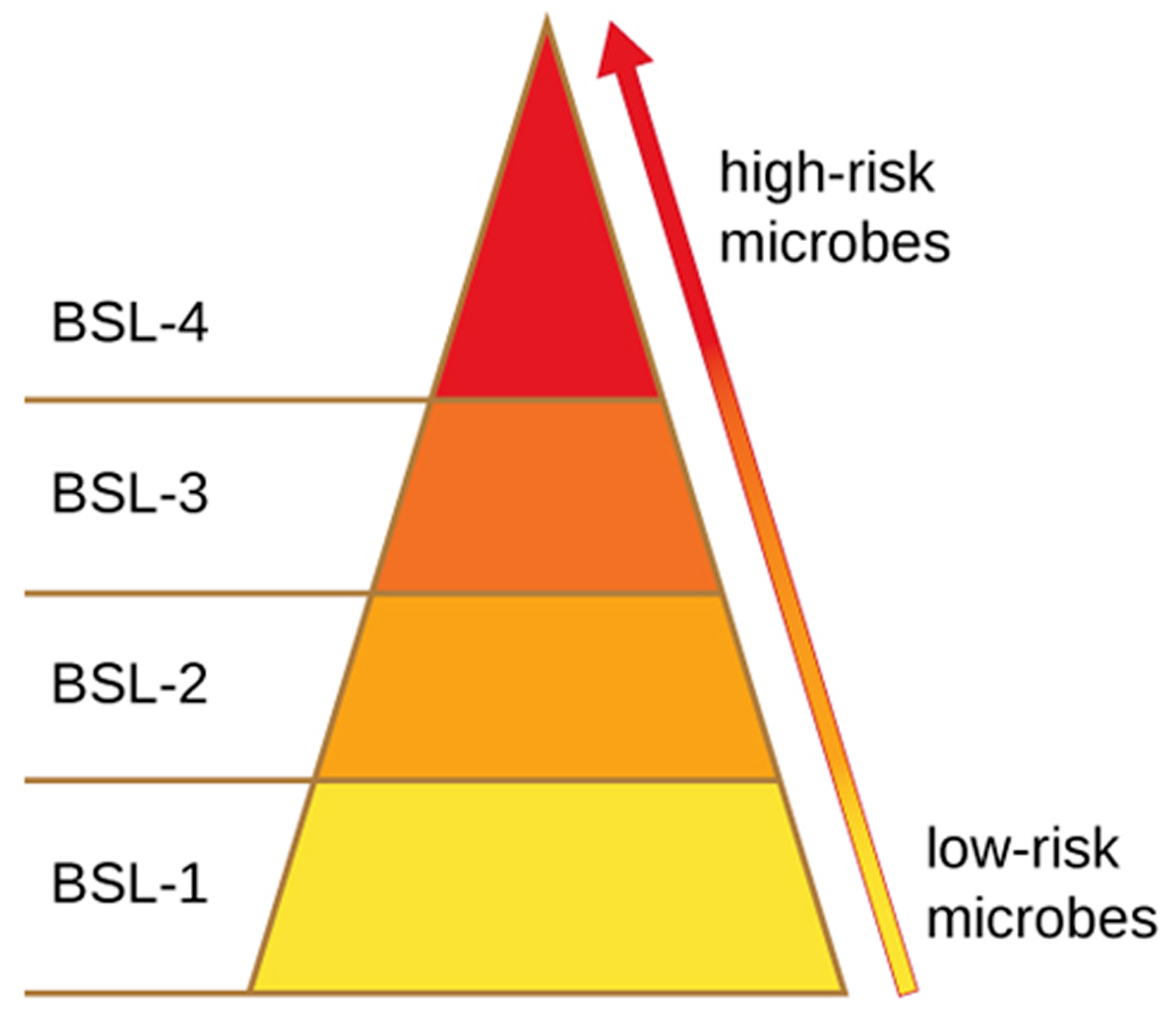Table of Contents |
When working with microbes, it is important to consider contamination and safety risks from two perspectives. First, it is important to consider the risk of the microbe contaminating surfaces and potentially spreading to other locations or people. For highly dangerous pathogens, this risk must be kept to an absolute minimum. Second, it is important to consider the risk that the work area may be contaminated by other microbes. If you want to study a particular microbe, it is important to make sure that your cultures are not contaminated by other organisms.
In the United States, the Centers for Disease Control and Prevention (CDC) and the National Institutes of Health (NIH) have established four biological safety levels (BSLs), and similar approaches have been adopted by other organizations and countries. To determine the BSL, the following considerations must be made:
Agents at the lowest BSL (BSL-1) require relatively few precautions because they do not cause infections in healthy adult humans.
EXAMPLE
This group includes nonpathogenic strains of Escherichia coli and Bacillus subtilis, both of which are commonly used in laboratory work. It also includes microbes that may cause disease in other organisms, but not in humans.Standard aseptic technique is used to prevent contamination of the work area or spread of the microbes. Work can be performed on open laboratory benches. Personnel wear standard personal protective equipment (such as a laboratory coat, goggles, and/or gloves as needed, depending on the type of work being performed). It is always important to have a sink for handwashing, which is standard in any microbiology laboratory, and doors to separate the laboratory from the rest of the building. Additional safety equipment may be available depending on the types of experiments performed in the laboratory, such as chemical safety equipment and fire extinguishers.
BSL-2 agents generally meet two criteria: 1) they pose moderate risk to humans in the laboratory and the surrounding community, and 2) they are indigenous (commonly found in that geographical area).
EXAMPLE
Staphylococcus aureus (which is a common cause of skin and other infections) and Salmonella species (which cause a variety of illnesses, including gastrointestinal infections) are included in this level. Viruses such as measles, mumps, and hepatitis are also included.Additional precautions include restricted access, the required personal protective equipment, face shields as needed, and the use of biological safety cabinets (BSCs) if there is a risk of aerosolization (airborne spread) of the agents. This type of laboratory has self-closing doors, an eyewash station, and an autoclave (a common laboratory device for sterilization using moist, pressurized heat that is found in many BSL-1 laboratories as well).
For agents to be classified as BSL-3, they are generally able to cause lethal infections through inhalation. These agents may be indigenous or from foreign locations.
EXAMPLE
Mycobacterium tuberculosis (which causes tuberculosis) and Bacillus anthracis (which causes anthrax) are included in this level. The West Nile virus and HIV are also classified at this level.These laboratories always have restricted access. When possible, workers are vaccinated against the agents with which they are working. Additionally, workers wear respirators that filter the air that they breathe and conduct their work in BSCs, which help to separate the environment inside the cabinet from the rest of the room. These laboratories have at least one hands-free sink, an eyewash station near the exit, and two sets of self-closing and locking doors controlling access. Additionally, these laboratories have directional airflow. This means that air is pulled through the laboratory from clean areas to potentially contaminated areas with no recirculation. This reduces the risk of the inadvertent spread of an airborne pathogen.
The most dangerous agents are classified as BSL-4. These pathogens often cause lethal illnesses. Most are from foreign locations and are easily transmitted by inhalation, although some are transmitted in other ways (such as through physical contact and/or contact with bodily fluids). Additionally, there are usually no treatments or vaccinations available to protect workers.
EXAMPLE
Agents classified at this level include the closely-related Ebola and Marburg viruses, which both cause severe hemorrhagic fevers. The smallpox virus is also classified at this level.Very few laboratories meet the standards necessary to work with these agents. In addition to all of the precautions used at lower BSLs, these laboratories also require the following from their workers:
The photo below shows workers preparing their protective suits for work in a BSL-4 laboratory. Note that the suits provide complete coverage and are attached to coiled tubes that supply air.

The table below summarizes the characteristics of all four CDC BSLs.
| BSLs | |||
|---|---|---|---|
| BSLs | Description | Examples | CDC Classification |
| BSL-4 | The microbes are dangerous and exotic, posing a high risk of aerosol-transmitted infections, which are frequently fatal without treatment or vaccines. Few labs are at this level. | Ebola and Marburg viruses |

|
| BSL-3 | The microbes are indigenous or exotic and cause serious or potentially lethal diseases through respiratory transmission. | M. tuberculosis | |
| BSL-2 | The microbes are typically indigenous and are associated with diseases of varying severity. They pose a moderate risk to workers and the environment. | S. aureus | |
| BSL-1 | The microbes are not known to cause disease in healthy hosts and pose minimal risk to workers and the environment. | Nonpathogenic strains of E. coli | |
As mentioned above, some microbiological laboratories use BSCs. These cabinets help to isolate the work environment containing the microbes of interest from the surrounding environment.
BSCs contain HEPA filters that remove particulate matter from the air. They may filter the air entering the cabinet, the air leaving the cabinet, or both. The choice of filtration depends on the priorities of the work. Filtering the air entering the cabinet protects the microbes being studied from contamination. Filtering the air exiting the cabinet prevents the microbes being studied from contaminating the environment.
BSCs are divided into three classes. The table below summarizes the characteristics of each type of cabinet, including the BSLs at which it can be used. Cabinets that protect personnel and the environment filter the air leaving the cabinet. Cabinets that protect the product filter the air entering the cabinet. As you can see, many do both.
As with BSLs, increasing numbers reflect an increased need for protection. Class I BSCs are used for relatively low-risk situations and filter air before it exits the cabinet. Class II BSCs use both directional airflow and barriers to contain infectious agents. Class III BSCs provide very high levels of protection and are the only type suitable for BSL-4 facilities. These cabinets are gas tight, have a double-door system, use one or two HEPA filters and an air incineration system to process air before it is vented outside, and have attached gloves sealed to the cabinet that workers can use to manipulate the materials inside.
| Biological Risks and BSCs | ||||
|---|---|---|---|---|
| Biological Risk Assessed | BSC Class | Protection of Personnel | Protection of Environment | Protection of Product |
| BSL-1, BSL-2, BSL-3 | I | Yes | Yes | No |
| BSL-1, BSL-2, BSL-3 | II | Yes | Yes | Yes |
| BSL-4 | III; II when used in a suit room with a suit | Yes | Yes | Yes |
Source: THIS CONTENT HAS BEEN ADAPTED FROM OPENSTAX’s “MICROBIOLOGY”. ACCESS FOR FREE AT openstax.org/details/books/microbiology
REFERENCES
World Health Organization. Smallpox. Retrieved November 3, 2022, from Smallpox www.who.int/.